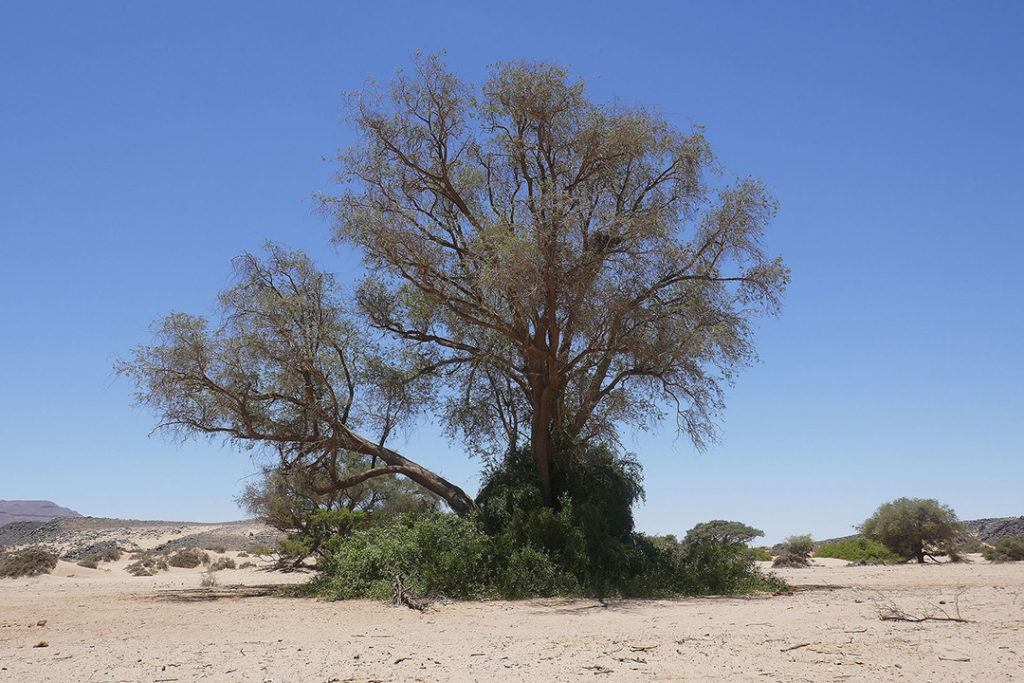
Eritrea
Memona Tree
Faidherbia albida (formerly Acacia albida)

General Description / Cultural Significance
The memona tree, or Faidherbia albida, is a type of acacia tree that grows in highland and lowland areas in the country of Eritrea. It is a well-known and highly valued tree in the harsh arid landscape, and important for food and shade, surviving where only few plants can. It grows small leaves and many tiny flowers that bloom all over the tree, emitting a pleasant and well-known fragrance. It provides edible fruit for livestock and is considered a keystone species for the ecosystem.
The tree’s bark and roots are used to treat respiratory infections, fevers, and malaria. The bark is also used traditionally to clean teeth. The tree itself is often planted to improve the soil in which it grows, as its roots spread and protect it from water. The seeds of the tree are edible once an extensive detoxifying treatment is completed. The wood can be used to build fires, and when strengthened through treatment, it can also be used for construction in some instances.
Climate Change/Conservation Status
The increasing frequency of droughts in recent decades has exacerbated already tenuous environmental conditions. As far back as 2017, reports from the Food and Agriculture Organization of the United Nations described how droughts over the past two decades had put the country in a precarious place in a short time. Soil erosion had taken its toll on soil fertility, crop yield, and water retention, and generally, reduced the vegetation across the country’s landscape.
The same year, a UNICEF report described how the ongoing drought impact brought about by El Niño had put malnutrition on an unprecedented emergency level with close to 23,000 children under the age of five suffering from acute malnutrition. This climate emergency is the stage set on which tens of thousands of Eritreans are fleeing their country, with thousands of people leaving every month. It is one of the world’s fastest emptying nations. They wish to leave behind a dictatorship requiring unending military service and other human rights violations, along with the merciless effects of climate change.
Only a century ago, Eritrea had an abundant and diversified ecosystem, but a long liberation war, recurrent droughts, and mismanagement of resources have drastically depleted the country, endangering many trees that are both culturally and economically valuable.
An important tree in the fight against desertification, the memona tree, which is not reported by the IUCN as endangered at this time, appears to be increasingly valuable in mitigating the effects of climate change.
Alternate Names
Apple ring acacia
Winter thorn
Sources
Akwei, I., 2018. Eritrea to power 40,000 people and businesses with US$6.56m hybrid solar systems. Pana Genius. [website]
Alam, M.E., 2017. Impact of Climate Change on Agro-Economy of Eritrea, Africa. Transactions of the Institute of Indian Geographers, [website] 39(2).
Alemu, S., et. al., 2021. Sengalia venosa. The IUCN Red List of Threatened Species. DOI: 10.2305/IUCN.UK.1998.RLTS.T34397A9859670.en
Bein, E., et. al., 1996. Useful trees and shrubs in Eritrea. 12th ed. [ebook] Nairobi: Regal Press Limited. ISBN: 9966-896-24-4
Chinsembu, K., 2015. Plants as antimalarial agents in Sub-Saharan Africa. Acta Tropica, [online] 152, pp.32-48. DOI: 10.1016/j.actatropica.2015.08.009
Climate Change Knowledge Portal, n.d. Eritrea. World Group Bank. [website]
Jeffrey, J., & Belloni, M., 2019. Eritrea’s farmers harvest early as climate change shifts crop patterns. Deutsche Welle. [website]
FAO, n.d. Forest Resources in Eritrea. Food and Agricultural Organization of the United Nations. [website]
Maxwell, C.F., 2002. Environmental Threats and Opportunities Assessment for Eritrea. [ebook] Asmara: USAID Eritrea Mission.
Mission of Eritrea to the United Nations. This statement can be found on the World Sensorium original website.
Schoemburg, J.F., 2009. Unique Trees Could Fight Famine in Africa. Frontiers in Ecology and the Environment, 7(8), pp. 401. [website]
Smith, D., 2015. Inside Eritrea: conscription and poverty drive exodus from secretive African state. The Guardian. [website]
Yaffe, A., 2017. Famine And Its Causes In The Horn Of Africa. The Guardian. [website]

